

Click any photo to view a large high-resolution image.
The Nabu 1100 is a S-100 Z-80 based system, normally running CP/M. The 1100 was intended as a small office/busniess computer, and was normally accompanied by a dedicated printer.
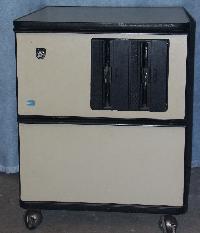 The Nabu 1100 is the size of a small file cabinet, and is constructed
from wood.
The Nabu 1100 is the size of a small file cabinet, and is constructed
from wood.
The computer is contained in the upper part, which is a slide out tray. The lower drawer is for storage.
Here is a view from the back.
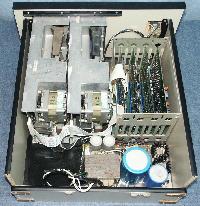 Here we have the "works in a drawer". On the left we see two full sized
8" floppy disk drives. Beside that on the right is an 8-slot S-100 card
cage. In the lower portion of the picture is the power supply.
Here we have the "works in a drawer". On the left we see two full sized
8" floppy disk drives. Beside that on the right is an 8-slot S-100 card
cage. In the lower portion of the picture is the power supply.
Installed S-100 cards: Andicom AC1100, ADM1000, ACIO, AFC1101
A second Nabu 1100 in the collection appears to be a development system for
the Nabu Personal Computer (below) - this machine looks identical to the one
above, except that instead of "works in a drawer", the top opens to provide
access to the cards. It also has a panel on the front with Audio/Video, and
game control connectors which connects to a S100
card containing the Audio/Video chips from the Nabu Personal Computer.
This machine has development software, and can develop/play games and other
software for the Nabu Personal Computer. Donated by Thai Nguyen.
Views:
Front,
Back,
Open.
 Nabu 1100 Documentation binders:
Nabu 1100 Documentation binders:
User Manual (3M PDF),
Technical Manual (14M PDF).
In 1982, Nabu, announced "The Nabu Network". This was a home computing system with NO local storage, retrieving and storing data over the cable-tv network. A pilot was launched in Ottawa, and a number of systems installed, however it never caught on.
Donated by Bob LeBlanc.
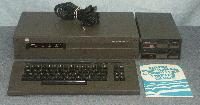 The Nabu Personal Computer. The long cable on top is the keyboard
cable - this unit was designed as a "set top" TV box, and the keyboard
could be relocated across the room. Note the optional 5.25" diskette
drives which were not included in the standard system.
The Nabu Personal Computer. The long cable on top is the keyboard
cable - this unit was designed as a "set top" TV box, and the keyboard
could be relocated across the room. Note the optional 5.25" diskette
drives which were not included in the standard system.
 Rear view of the Nabu Personal computer. Note the connections for
cable TV.
Rear view of the Nabu Personal computer. Note the connections for
cable TV.
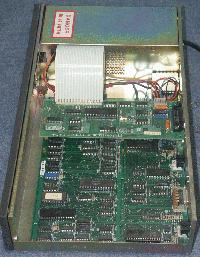 Inside the Nabu Personal Computer. The board on top is an optional
floppy disk controller. Floppy disks were provided on the "developers
version" of the machine, allowing it to boot CP/M and be used to
develop Network applications.
Inside the Nabu Personal Computer. The board on top is an optional
floppy disk controller. Floppy disks were provided on the "developers
version" of the machine, allowing it to boot CP/M and be used to
develop Network applications.
The standard version of the machine also ran CP/M, however it was hidden from the user and no access was provided to the CP/M system prompt.
 The end-user version of this machine did NOT have diskette drives. It
used this "Adapter" to allow booting and loading of software over the
cable tv system.
The end-user version of this machine did NOT have diskette drives. It
used this "Adapter" to allow booting and loading of software over the
cable tv system.
Here is a look inside.
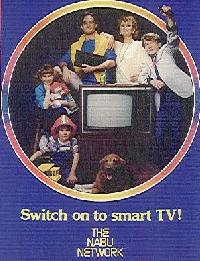 Promotional poster for the Nabu Network.
Promotional poster for the Nabu Network.
The Nabu 1200/1600 is an 8086 based machine with 512k of memory, 4 serial ports, an 80 track (720k) floppy drive and a 5 or 10Meg hard disk drive. The system is referred to in internal documentation as the 1200, however most of the released material calls it the Nabu 1600.
Operating systems available for the machine included: CP/M-86, Xenix and a little known local Unix-alike called "QUNIX" which later became "QNX" and is still a major player in the embedded OS market.
This was my first machine with a hard drive, and I became very familier with QNX. As the 1600 did not have integrated video displays, I have several Volker Craig terminals with which to access them. It was to access these machines that I developed the prototype data switch which later became the NewBridge "MainStreet" unit that won "Editors Choice" in a PC magazine review. Having access to a Unix system and its tools allowed me to expand into more complex software projects. Many of the tools my company markets today were first developed on the Nabu.
At one time I had 4 Nabu 1600's, however some time ago I gave them all away. I have since reacquired the CPU unit from one of my original 1600's, however it's drive unit had been lost. Subsequent to this, I have located another Nabu 1600 drive unit, allowing me to assemble the complete system shown here.
One Nabu 1600 CPU was donated by Bob Johnston, and the Nabu 1600 drive unit was donated by Mike Kenzie. Another complete Nabu 1600 was donated by Markus Wandel.
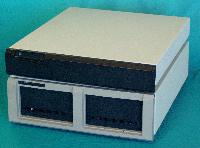 The Nabu 1600. On top is the CPU unit, and the bottom is the disk unit.
Note that Nabu's were available in two colors - the CPU unit came from
a Black system, and the disk unit came from a Grey system.
The Nabu 1600. On top is the CPU unit, and the bottom is the disk unit.
Note that Nabu's were available in two colors - the CPU unit came from
a Black system, and the disk unit came from a Grey system.
 This plain front panel gave no clue to the powerful machine (for the day)
which lie behind it.
This plain front panel gave no clue to the powerful machine (for the day)
which lie behind it.
Open views:
Left side,
Right side.
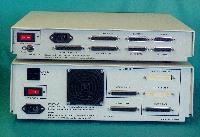 Short floppy and hard drive cables connected the CPU to the disk unit.
The four serial ports were labled "Console", "Printer", "Spare 1" and
"Spare 2", however all of them could be used for multi-user access with
four independant terminals.
Short floppy and hard drive cables connected the CPU to the disk unit.
The four serial ports were labled "Console", "Printer", "Spare 1" and
"Spare 2", however all of them could be used for multi-user access with
four independant terminals.
This is an earlier edition CPU unit - later CPU's did not have a separate
power switch, as they were intended to be plugged into the switched outlet
on the back of the disk unit.
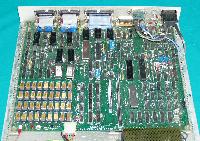 The leftmost connector on the front of the board connected the memory expansion
which can be seen in previous photos. The rightmost connector conencted a
proprietary memory management unit which was used by the XENIX OS, but was not
required for QNX or CP/M.
The leftmost connector on the front of the board connected the memory expansion
which can be seen in previous photos. The rightmost connector conencted a
proprietary memory management unit which was used by the XENIX OS, but was not
required for QNX or CP/M.
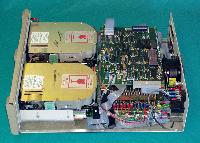 The disk unit contains a Western Digital WD-1001 hard drive controller and
two ST-412 10MB drives. The closer hard drive was replaced by a TM-100-4 80
track floppy drive in some configurations - you can see the floppy connector
tucked underneath.
The disk unit contains a Western Digital WD-1001 hard drive controller and
two ST-412 10MB drives. The closer hard drive was replaced by a TM-100-4 80
track floppy drive in some configurations - you can see the floppy connector
tucked underneath.